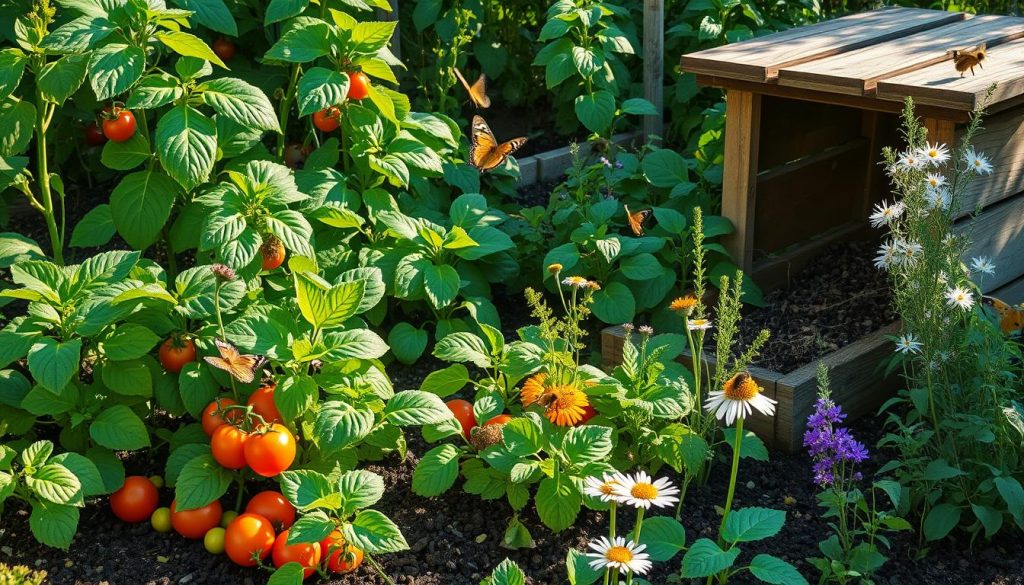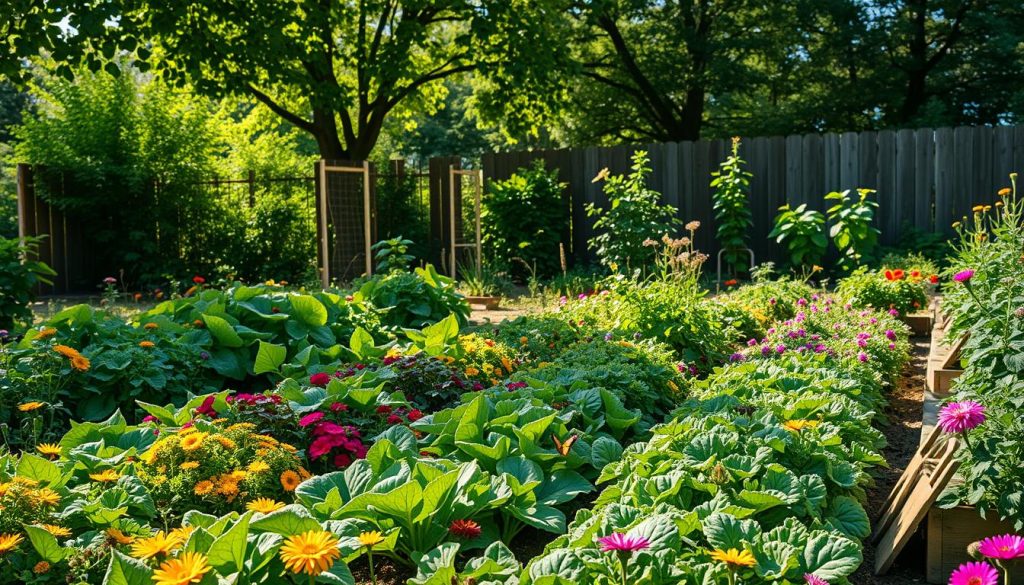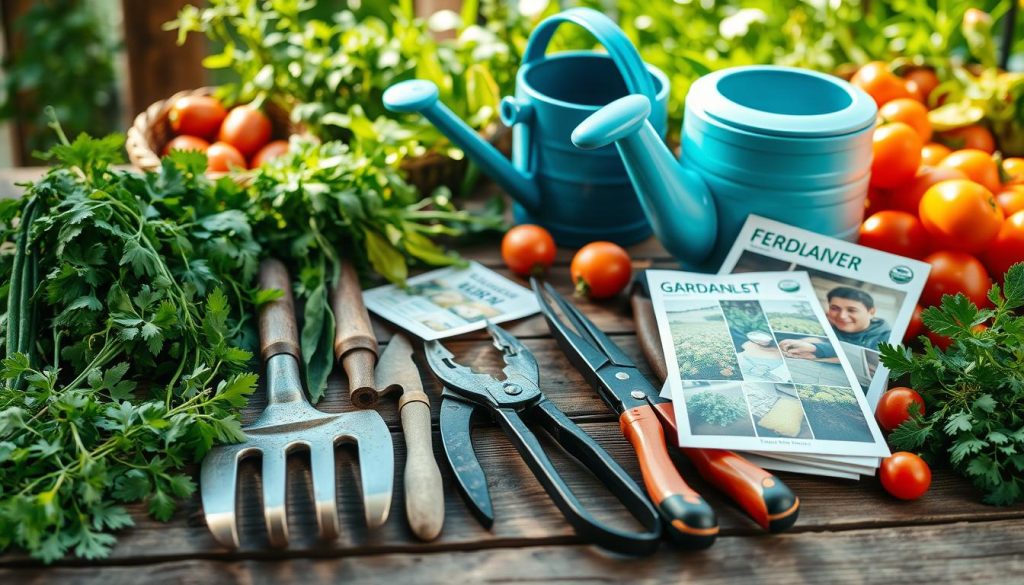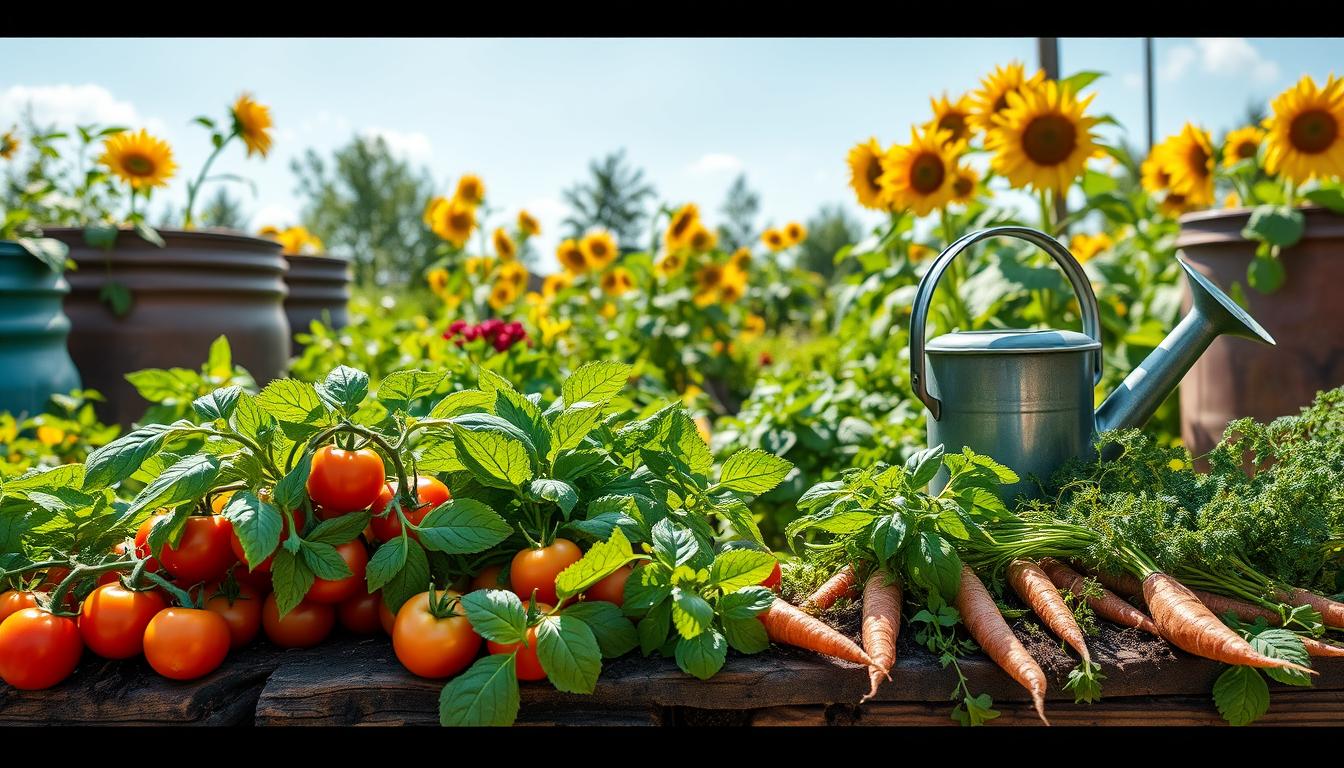I’m excited to share my easy guide for growing organic veggies at home. It’s packed with tips to get you started. You’ll learn the basics of gardening, from choosing the right spot to harvesting and storing your produce. This way, you can enjoy fresh, healthy veggies right in your backyard.
Whether you’re new to gardening or have experience, my goal is to help you grow your own organic veggies. I’ll share the best tips and advice. With the right techniques and a bit of practice, you’ll have a thriving garden in no time.
Why Choose Organic Vegetable Gardening?
Exploring organic vegetable gardening is exciting. It offers many benefits for growing your own food naturally. Using eco-friendly gardening tips helps your plants grow well in a healthy environment. Organic gardening is more than avoiding harmful chemicals. It’s about creating a balanced ecosystem that’s good for our planet.
Organic vegetable gardening has many advantages. Here are a few:
- Improved soil health through natural compost and mulch
- Increased biodiversity by welcoming beneficial insects and microorganisms
- Reduced environmental pollution by avoiding synthetic chemicals
- Healthier produce with more nutrients and better taste
Using natural gardening techniques and eco-friendly tips makes gardening more rewarding. It’s great for both new and experienced gardeners. Organic vegetable gardening lets you connect with nature and grow your own healthy food.

As we look into organic gardening, we’ll see its environmental and health benefits. Making smart choices in gardening can positively impact our environment and health.
Choosing the Right Location for Your Garden
When starting a sustainable vegetable garden, picking the right spot is key. I focus on sunlight and soil quality. Most veggies need at least six hours of direct sunlight daily.
Soil quality is also vital for a healthy garden. I check the soil type, pH level, and nutrients. This helps me decide if I need to make any changes. With the right location and soil, my veggies will grow well.

Sunlight Requirements
- Most vegetables require at least six hours of direct sunlight per day
- Some vegetables, such as lettuce and herbs, can tolerate partial shade
- South-facing gardens typically receive the most sunlight
Soil Quality Considerations
Soil quality is crucial for growing veggies. I look at a few things when checking my soil:
- Soil type (clay, silt, sand, or loam)
- pH level (most vegetables prefer a slightly acidic to neutral soil pH)
- Nutrient content (nitrogen, phosphorus, potassium)
Knowing these details helps me create a great environment for my veggies. I use organic gardening hacks and sustainable methods to make it happen.
Selecting the Best Organic Seeds
As a gardener, I know picking the right seeds is key for growing veggies without chemicals. With many choices, finding the best seeds can feel daunting. I’ll talk about heirloom vs. hybrid seeds and where to find organic ones.
Heirloom vs. Hybrid Seeds
Heirloom seeds can be saved and replanted, offering unique tastes and looks. They’re perfect for those who love to try new things in their garden. Hybrid seeds, however, are bred for traits like more yield or disease resistance. They’re great for those aiming for a big harvest.
Where to Buy Organic Seeds
There are many places to buy organic seeds. You can shop online, at gardening stores, or even seed libraries. Brands like Burpee and Seed Savers Exchange are well-known for their organic seeds. Here are some tips for buying organic seeds:
- Look for seeds that are certified organic by the USDA
- Check the seed package for information on the seed’s origin and variety
- Consider buying seeds from local farmers or gardening clubs to support your community

Essential Tools for Organic Gardening
As I explore organic vegetable gardening, I’ve learned that the right tools are key. For environmentally-friendly gardening, choosing the right tools is crucial. Here, I’ll share the must-have tools for organic gardening and some valuable tips.
You’ll need basic hand tools like a trowel, rake, and hoe to start. These help prepare soil, plant seeds, and keep your garden in check. Also, a soil testing kit is a smart buy. It shows your soil’s pH and nutrient levels, guiding your gardening decisions.
Gardening Hand Tools
- Trowel: for planting seeds and seedlings
- Rake: for soil preparation and weed removal
- Hoe: for weeding and soil cultivation
Soil Testing Kits
A soil testing kit is a simple way to check your soil’s health. It helps spot nutrient gaps, letting you adjust your garden’s care. This is vital for a thriving organic garden and eco-friendly gardening.

With these essential tools and some organic gardening tips, you’re set for a healthy garden. Choose tools made from sustainable materials and designed for the environment. Happy gardening!
| Tool | Description | Benefits |
|---|---|---|
| Trowel | Planting seeds and seedlings | Easy to use, precise planting |
| Rake | Soil preparation and weed removal | Effective weed control, soil aeration |
| Hoe | Weeding and soil cultivation | Easy weeding, soil preparation |
Preparing Your Garden Soil
As I work on growing my own organic veggies, I’ve learned how key soil preparation is. It’s the first step to a healthy garden. With some basic advice and natural methods, I can make my soil rich and perfect for my plants.
Compost is a big deal in organic gardening. It adds nutrients and makes the soil better. Adding compost helps my plants grow strong and healthy. Some benefits of compost are:
- Improved soil fertility
- Increased water retention
- Reduced soil erosion
To make my soil better, I can use compost, natural fertilizers, and cover crops. These methods help my garden grow strong and last long.
Importance of Compost
Compost is full of nutrients that help my plants grow. Making my own compost at home is a great way to reduce waste. Here are some tips for composting at home:
- Collect kitchen scraps and yard waste
- Make a compost pile with “green” and “brown” materials
- Turn the compost pile often to help it break down
How to Amend Soil Organically
Improving my soil organically is easy with natural methods. By following these tips, I can make my soil healthy and balanced. Adding compost, using natural fertilizers, and planting cover crops are good ways to do this. These steps help my garden grow well and give me fresh, organic food for years.
Watering Techniques for Healthy Growth
As I share eco-friendly gardening tips, I stress the need for proper watering. Watering is key in organic gardening. It affects plant health and productivity.
Using the right watering methods is crucial. Drip irrigation and soaker hoses are effective. They deliver water to the roots, cutting down on evaporation and runoff.
Methods of Watering
- Drip irrigation: This method delivers water directly to the roots through a network of tubes and drippers.
- Soaker hoses: These hoses have small holes for water to seep out, giving plants a steady water supply.
Timing Your Watering Schedule
Timing your watering is important to avoid too much or too little water. Water your plants early in the morning. This lets them soak up water all day. By following these tips, you can grow a healthy and productive garden.
Common Organic Vegetable Varieties to Grow
Starting with organic gardening can feel overwhelming with so many vegetable options. With the right tips, you can grow a variety of tasty and healthy veggies. It’s key to think about your climate, soil, and what you like when picking varieties.
Beginners often start with tomatoes, cucumbers, and carrots. These are great because they’re easy to care for and grow well in many conditions. Adding these to your garden will help you enjoy a big harvest and improve your gardening skills.
Beginners’ Favorites
- Tomatoes: With over 7,500 varieties, tomatoes are a top pick for gardeners. They grow quickly and can be ready in 60 days.
- Cucumbers: These warm-season veggies grow on trellises or in pots. They’re easy to care for and ready in about 50 days.
- Carrots: Carrots are cool-season and need well-draining soil and sun. They’re ready in 60 days and add a lot to your garden.
Season-Specific Choices
It’s also important to pick varieties that match the season and your local weather. Choosing the right ones for each season means you can harvest all year. This makes your gardening journey more rewarding.
| Season | Vegetable Varieties |
|---|---|
| Spring | Broccoli, kale, spinach |
| Summer | Tomatoes, cucumbers, carrots |
| Fall | Carrots, beets, lettuce |
| Winter | Brussels sprouts, kale, spinach |
By using these tips and tricks, you can make a vibrant and diverse organic garden. It will give you a steady supply of fresh veggies all year.
Dealing with Pests Naturally
Growing my own organic veggies has taught me about pests. But, I don’t use synthetic pesticides. Instead, I choose methods that keep the ecosystem balanced. Companion planting is a key strategy I use.
Companion Planting Strategies
Companion planting means growing different plants together for better health. For instance, marigolds with tomatoes can fight nematodes. Basil makes nearby veggies taste better. Here are some other good plants to grow together:
- Nasturtiums, which repel aphids and whiteflies
- Radishes, which can help to repel cucumber beetles
- Chives, which can improve the growth of carrots and other vegetables
Organic Pesticides and Solutions
Companion planting isn’t the only way to fight pests. Organic pesticides like neem oil, diatomaceous earth, and insecticidal soap work too. These methods help keep my garden healthy and pest-free, all without chemicals.
Tips for Harvesting and Storing Veggies
As we near the end of our organic vegetable gardening journey, it’s time to enjoy the fruits of our labor. Knowing when to harvest is key. Proper timing ensures maximum flavor and nutrition.
After harvesting, it’s important to store your veggies right. You can use refrigeration, freezing, or canning. These methods help keep your harvest fresh for months. This way, you can enjoy your homegrown produce all year.
Organic vegetable gardening requires effort, but the rewards are great. You’ll enjoy growing your own food and the delicious, nutritious veggies. With the tips from this guide, you’re ready to become a successful organic gardener. Happy harvesting!

